Biochem ch 12 - Study guides, Class notes & Summaries
Looking for the best study guides, study notes and summaries about Biochem ch 12? On this page you'll find 34 study documents about Biochem ch 12.
Page 3 out of 34 results
Sort by
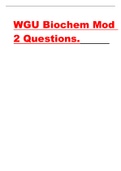
-
WGU Biochem Mod 2 Questions.
- Exam (elaborations) • 22 pages • 2022
-
- $11.49
- + learn more
WGU Biochem Mod 2 Questions. Unit 2 Quiz 1. Which level of protein structure is disrupted through the hydrolysis of peptide bonds? a. Primary b. Tertiary c. Secondary d. Quaternary Answer: A. The primary structure of a protein is the sequence of amino acids held together by peptide bonds. Peptide bonds are formed by dehydration reactions and disrupted by hydrolysis. 2. A mutation in the beta-hemoglobin gene, which results in the replacement of the amino acid glutamate in position 6 w...
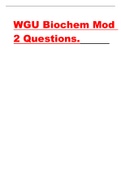
-
WGU Biochem Mod 2 Questions.
- Exam (elaborations) • 22 pages • 2022
-
- $10.99
- + learn more
WGU Biochem Mod 2 Questions. Unit 2 Quiz 1. Which level of protein structure is disrupted through the hydrolysis of peptide bonds? a. Primary b. Tertiary c. Secondary d. Quaternary Answer: A. The primary structure of a protein is the sequence of amino acids held together by peptide bonds. Peptide bonds are formed by dehydration reactions and disrupted by hydrolysis. 2. A mutation in the beta-hemoglobin gene, which results in the replacement of the amino acid glutamate in position 6 w...
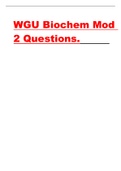
-
WGU Biochem Mod 2 Questions.
- Exam (elaborations) • 22 pages • 2022
-
- $10.99
- + learn more
WGU Biochem Mod 2 Questions. Unit 2 Quiz 1. Which level of protein structure is disrupted through the hydrolysis of peptide bonds? a. Primary b. Tertiary c. Secondary d. Quaternary Answer: A. The primary structure of a protein is the sequence of amino acids held together by peptide bonds. Peptide bonds are formed by dehydration reactions and disrupted by hydrolysis. 2. A mutation in the beta-hemoglobin gene, which results in the replacement of the amino acid glutamate in position 6 w...
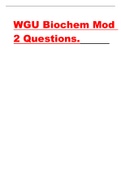
-
WGU Biochem Mod 2 Questions
- Exam (elaborations) • 22 pages • 2022
-
- $13.99
- + learn more
WGU Biochem Mod 2 Questions. Unit 2 Quiz 1. Which level of protein structure is disrupted through the hydrolysis of peptide bonds? a. Primary b. Tertiary c. Secondary d. Quaternary Answer: A. The primary structure of a protein is the sequence of amino acids held together by peptide bonds. Peptide bonds are formed by dehydration reactions and disrupted by hydrolysis. 2. A mutation in the beta-hemoglobin gene, which results in the replacement of the amino acid glutamate in position 6 w...
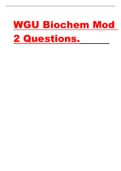
-
WGU Biochem Mod 2 Questions
- Exam (elaborations) • 22 pages • 2022
-
- $14.49
- + learn more
WGU Biochem Mod 2 Questions. Unit 2 Quiz 1. Which level of protein structure is disrupted through the hydrolysis of peptide bonds? a. Primary b. Tertiary c. Secondary d. Quaternary Answer: A. The primary structure of a protein is the sequence of amino acids held together by peptide bonds. Peptide bonds are formed by dehydration reactions and disrupted by hydrolysis. 2. A mutation in the beta-hemoglobin gene, which results in the replacement of the amino acid glutamate in position 6 w...
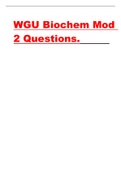
-
WGU Biochem Mod 2 Questions
- Exam (elaborations) • 22 pages • 2022
-
- $15.49
- + learn more
WGU Biochem Mod 2 Questions. Unit 2 Quiz 1. Which level of protein structure is disrupted through the hydrolysis of peptide bonds? a. Primary b. Tertiary c. Secondary d. Quaternary Answer: A. The primary structure of a protein is the sequence of amino acids held together by peptide bonds. Peptide bonds are formed by dehydration reactions and disrupted by hydrolysis. 2. A mutation in the beta-hemoglobin gene, which results in the replacement of the amino acid glutamate in position 6 w...
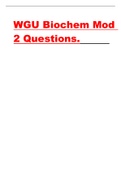
-
WGU Biochem Mod 2 Questions.
- Exam (elaborations) • 22 pages • 2022
-
- $12.99
- + learn more
WGU Biochem Mod 2 Questions. Unit 2 Quiz 1. Which level of protein structure is disrupted through the hydrolysis of peptide bonds? a. Primary b. Tertiary c. Secondary d. Quaternary Answer: A. The primary structure of a protein is the sequence of amino acids held together by peptide bonds. Peptide bonds are formed by dehydration reactions and disrupted by hydrolysis. 2. A mutation in the beta-hemoglobin gene, which results in the replacement of the amino acid glutamate in position 6 w...
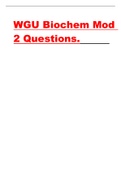
-
WGU Biochem Mod 2 Questions.
- Exam (elaborations) • 22 pages • 2022
-
- $12.99
- + learn more
WGU Biochem Mod 2 Questions. Unit 2 Quiz 1. Which level of protein structure is disrupted through the hydrolysis of peptide bonds? a. Primary b. Tertiary c. Secondary d. Quaternary Answer: A. The primary structure of a protein is the sequence of amino acids held together by peptide bonds. Peptide bonds are formed by dehydration reactions and disrupted by hydrolysis. 2. A mutation in the beta-hemoglobin gene, which results in the replacement of the amino acid glutamate in position 6 w...
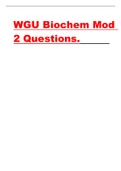
-
WGU Biochem Mod 2 Questions
- Exam (elaborations) • 22 pages • 2022
-
- $10.49
- + learn more
WGU Biochem Mod 2 Questions. Unit 2 Quiz 1. Which level of protein structure is disrupted through the hydrolysis of peptide bonds? a. Primary b. Tertiary c. Secondary d. Quaternary Answer: A. The primary structure of a protein is the sequence of amino acids held together by peptide bonds. Peptide bonds are formed by dehydration reactions and disrupted by hydrolysis. 2. A mutation in the beta-hemoglobin gene, which results in the replacement of the amino acid glutamate in position 6 w...
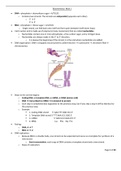
-
BIOCHEM C785 Kaleys Comprehensive Study Guide final (Completed ) BIOCHEM C785 Kaleys Comprehensive Study Guide final
- Other • 40 pages • 2021
-
- $19.05
- + learn more
BIOCHEM C785 Kaleys Comprehensive Study Guide final (Completed ) BIOCHEM C785 Kaleys Comprehensive Study Guide final-DNA = phosphate + deoxyribose sugar + A/T/C/G o Contains two strands. The strands are antiparallel (opposite each other). o 5’ → 3’ 3’ ← 5’ RNA = phosphate + ribose sugar + A/U/C/G o Single strand, can fold back onto itself and form pairs between itself (stem‐ loop). Each nucleic acid is made up of polymers (many monomers) that are called nucleotides. o Nucle...

Study stress? For sellers on Stuvia, these are actually golden times. KA-CHING! Earn from your study resources too and start uploading now. Discover all about earning on Stuvia


